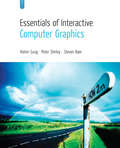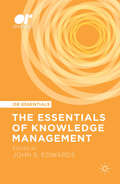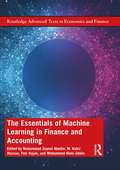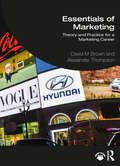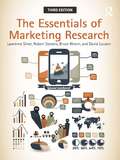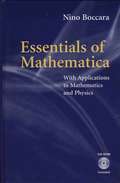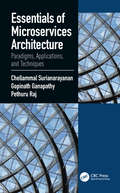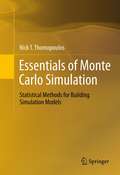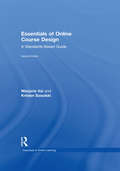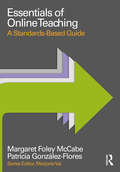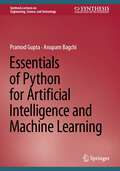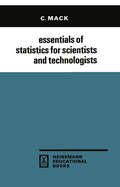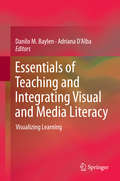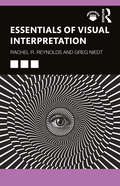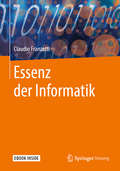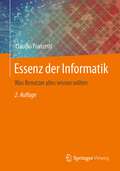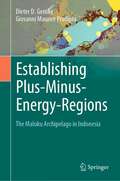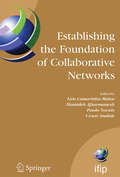- Table View
- List View
Essentials of Interactive Computer Graphics: Concepts and Implementation
by Kelvin SungThis undergraduate-level computer graphics text provides the reader with conceptual and practical insights into how to approach building a majority of the interactive graphics applications they encounter daily. As each topic is introduced, students are guided in developing a software library that will support fast prototyping of moderately complex
The Essentials of Knowledge Management (OR Essentials)
by John S. EdwardsThis book reviews the field of Knowledge Management, taking a holistic approach that includes both "soft" and "hard" aspects. It provides a broad perspective on the field, rather than one based on a single viewpoints from Computer Science or Organizational Learning, offering a comprehensive and integrated conception of Knowledge Management. The chapters represent the best Knowledge Management articles published in the 21st century in Knowledge Management Research & Practice and the European Journal of Information Systems, with contributors including Ikujiro Nonaka, Frada Burstein, and David Schwartz. Most of the chapters contribute significantly to practise as well as theory. The OR Essentials series presents a unique cross-section of high quality research work fundamental to understanding contemporary issues and research across a range of Operational Research topics. It brings together some of the best research papers from the highly respected journals of the Operational Research Society, also published by Palgrave Macmillan.
The Essentials of Machine Learning in Finance and Accounting (Routledge Advanced Texts in Economics and Finance)
by Mohammad Zoynul Abedin M. Kabir Hassan Petr Hajek Mohammed Mohi UddinThis book introduces machine learning in finance and illustrates how we can use computational tools in numerical finance in real-world context. These computational techniques are particularly useful in financial risk management, corporate bankruptcy prediction, stock price prediction, and portfolio management. The book also offers practical and managerial implications of financial and managerial decision support systems and how these systems capture vast amount of financial data. Business risk and uncertainty are two of the toughest challenges in the financial industry. This book will be a useful guide to the use of machine learning in forecasting, modeling, trading, risk management, economics, credit risk, and portfolio management.
The Essentials of Machine Learning in Finance and Accounting (Routledge Advanced Texts in Economics and Finance)
by Mohammad Zoynul Abedin M. Kabir Hassan Petr Hajek Mohammed Mohi UddinThis book introduces machine learning in finance and illustrates how we can use computational tools in numerical finance in real-world context. These computational techniques are particularly useful in financial risk management, corporate bankruptcy prediction, stock price prediction, and portfolio management. The book also offers practical and managerial implications of financial and managerial decision support systems and how these systems capture vast amount of financial data. Business risk and uncertainty are two of the toughest challenges in the financial industry. This book will be a useful guide to the use of machine learning in forecasting, modeling, trading, risk management, economics, credit risk, and portfolio management.
Essentials of Marketing: Theory and Practice for a Marketing Career
by David Brown Alex ThompsonThis comprehensive textbook introduces students to all the core principles of marketing practice using an employability-focused approach. Essentials of Marketing is underpinned by six pillars, which flow through each chapter: marketing ethics, sustainability, stakeholder engagement, globalisation, the power of new media, and measuring success. The book demystifies theory by placing it in contexts which are recognisable to a diverse readership, using real-life case studies and examples designed to engage today’s technologically savvy and internationally oriented students. The book includes a comprehensive running case study in which readers are invited to adopt the roles of marketing assistant, marketing manager, and marketing director within regional markets, applying the knowledge that they have learned in each chapter into modern, realistic contexts, which simulate a marketing career. Key features to aid learning and comprehension include case studies, chapter objectives and summaries, key learning points, and key questions. With a uniquely accessible and applied approach, Essentials of Marketing is designed as a core text for undergraduate and postgraduate students studying Introduction to marketing, marketing management, and principles of marketing modules. Digital learning resources include a comprehensive instructor’s manual to guide interaction with the applied case study, PowerPoint slides, and a test bank.
Essentials of Marketing: Theory and Practice for a Marketing Career
by David Brown Alex ThompsonThis comprehensive textbook introduces students to all the core principles of marketing practice using an employability-focused approach. Essentials of Marketing is underpinned by six pillars, which flow through each chapter: marketing ethics, sustainability, stakeholder engagement, globalisation, the power of new media, and measuring success. The book demystifies theory by placing it in contexts which are recognisable to a diverse readership, using real-life case studies and examples designed to engage today’s technologically savvy and internationally oriented students. The book includes a comprehensive running case study in which readers are invited to adopt the roles of marketing assistant, marketing manager, and marketing director within regional markets, applying the knowledge that they have learned in each chapter into modern, realistic contexts, which simulate a marketing career. Key features to aid learning and comprehension include case studies, chapter objectives and summaries, key learning points, and key questions. With a uniquely accessible and applied approach, Essentials of Marketing is designed as a core text for undergraduate and postgraduate students studying Introduction to marketing, marketing management, and principles of marketing modules. Digital learning resources include a comprehensive instructor’s manual to guide interaction with the applied case study, PowerPoint slides, and a test bank.
The Essentials of Marketing Research
by Lawrence Silver Robert E. Stevens Bruce Wrenn David L. LoudonIdentifying and assessing the ways in which changes in the marketing mix affect consumer behavior is key to a successful marketing strategy. The Essentials of Marketing Research guides the student in designing, conducting and interpreting marketing research. This comprehensive textbook covers the full range of topics, including: Secondary research and data mining Internet marketing research Qualitative and exploratory research Statistical analysis Marketing research ethics With learning objectives at the beginning of each chapter, a host of cases and a comprehensive companion website, this book offers a range of tools to help students develop and test their research and analytical skills.
The Essentials of Marketing Research
by Lawrence Silver Robert E. Stevens Bruce Wrenn David L. LoudonIdentifying and assessing the ways in which changes in the marketing mix affect consumer behavior is key to a successful marketing strategy. The Essentials of Marketing Research guides the student in designing, conducting and interpreting marketing research. This comprehensive textbook covers the full range of topics, including: Secondary research and data mining Internet marketing research Qualitative and exploratory research Statistical analysis Marketing research ethics With learning objectives at the beginning of each chapter, a host of cases and a comprehensive companion website, this book offers a range of tools to help students develop and test their research and analytical skills.
Essentials of Mathematica: With Applications to Mathematics and Physics
by Nino BoccaraThis book teaches how to use Mathematica to solve a wide variety of problems in mathematics and physics. It is based on the lecture notes of a course taught at the University of Illinois at Chicago to advanced undergrad and graduate students. The book is illustrated with many detailed examples that require the student to construct meticulous, step-by-step, easy to read Mathematica programs. The first part, in which the reader learns how to use a variety of Mathematica commands, contains examples, not long explanations; the second part contains attractive applications.
Essentials of Microservices Architecture: Paradigms, Applications, and Techniques
by Chellammal Surianarayanan Gopinath Ganapathy Raj PethuruMicroservices architecture (MSA) is increasingly popular with software architects and engineers as it accelerates software solution design, development, and deployment in a risk-free manner. Placing a software system into a production environment is elegantly simplified and sped up with the use of MSA development platforms, runtime environments, acceleration engines, design patterns, integrated frameworks, and related tools. The MSA ecosystem is expanding with third-party products that automate as many tasks as possible. MSA is being positioned as the enterprise-grade and agile-application design method. This book covers in-depth the features and facilities that make up the MSA ecosystem. Beginning with an overview of Service-Oriented Architecture (SOA) that covers the Common Object Request Broker Architecture (CORBA), Distributed Component Object Model (DCOM), and Remote Method Invocation (RMI), the book explains the basic essentials of MSA and the continuous delivery of applications to customers. The book gives software developers insight into: Current and emerging communication models Key architectural elements of MSA-based applications Designing efficient APIs for microservices MSA middleware platforms such as REST, SOAP, Apache Thrift, and gRPC Microservice discovery and the API gateway Service orchestration and choreography for composing individual services to achieve a useful business process Database transactions in MSA-centric applications Design, composition, security, and deployment patterns MSA security Modernizing legacy applications The book concludes with a chapter on composing and building powerful microservices. With the exponential growth of IoT devices, microservices are being developed and deployed on resource-constrained but resource-intensive devices in order to provide people-centric applications. The book discusses the challenges of these applications. Finally, the book looks at the role of microservices in smart environments and upcoming trends including ubiquitous yet disappearing microservices.
Essentials of Microservices Architecture: Paradigms, Applications, and Techniques
by Chellammal Surianarayanan Gopinath Ganapathy Raj PethuruMicroservices architecture (MSA) is increasingly popular with software architects and engineers as it accelerates software solution design, development, and deployment in a risk-free manner. Placing a software system into a production environment is elegantly simplified and sped up with the use of MSA development platforms, runtime environments, acceleration engines, design patterns, integrated frameworks, and related tools. The MSA ecosystem is expanding with third-party products that automate as many tasks as possible. MSA is being positioned as the enterprise-grade and agile-application design method. This book covers in-depth the features and facilities that make up the MSA ecosystem. Beginning with an overview of Service-Oriented Architecture (SOA) that covers the Common Object Request Broker Architecture (CORBA), Distributed Component Object Model (DCOM), and Remote Method Invocation (RMI), the book explains the basic essentials of MSA and the continuous delivery of applications to customers. The book gives software developers insight into: Current and emerging communication models Key architectural elements of MSA-based applications Designing efficient APIs for microservices MSA middleware platforms such as REST, SOAP, Apache Thrift, and gRPC Microservice discovery and the API gateway Service orchestration and choreography for composing individual services to achieve a useful business process Database transactions in MSA-centric applications Design, composition, security, and deployment patterns MSA security Modernizing legacy applications The book concludes with a chapter on composing and building powerful microservices. With the exponential growth of IoT devices, microservices are being developed and deployed on resource-constrained but resource-intensive devices in order to provide people-centric applications. The book discusses the challenges of these applications. Finally, the book looks at the role of microservices in smart environments and upcoming trends including ubiquitous yet disappearing microservices.
Essentials of Monte Carlo Simulation: Statistical Methods for Building Simulation Models
by Nick T. ThomopoulosEssentials of Monte Carlo Simulation focuses on the fundamentals of Monte Carlo methods using basic computer simulation techniques. The theories presented in this text deal with systems that are too complex to solve analytically. As a result, readers are given a system of interest and constructs using computer code, as well as algorithmic models to emulate how the system works internally. After the models are run several times, in a random sample way, the data for each output variable(s) of interest is analyzed by ordinary statistical methods. This book features 11 comprehensive chapters, and discusses such key topics as random number generators, multivariate random variates, and continuous random variates. Over 100 numerical examples are presented as part of the appendix to illustrate useful real world applications. The text also contains an easy to read presentation with minimal use of difficult mathematical concepts. Very little has been published in the area of computer Monte Carlo simulation methods, and this book will appeal to students and researchers in the fields of Mathematics and Statistics.
Essentials of Online Course Design: A Standards-Based Guide (Essentials of Online Learning)
by Marjorie Vai Kristen SosulskiIn spite of the proliferation of online learning, creating online courses can still evoke a good deal of frustration, negativity, and wariness in those who need to create them. The second edition of Essentials of Online Course Design takes a fresh, thoughtfully designed, step-by-step approach to online course development. At its core is a set of standards that are based on best practices in the field of online learning and teaching. Pedagogical, organizational, and visual design principles are presented and modeled throughout the book, and users will quickly learn from the guide’s hands-on approach. The course design process begins with the elements of a classroom syllabus which, after a series of guided steps, easily evolve into an online course outline. The guide’s key features include: a practical approach informed by theory clean interior design that offers straightforward guidance from page one clear and jargon-free language examples, screenshots, and illustrations to clarify and support the text a checklist of online course design standards that readers can use to self-evaluate. a Companion Website with examples, adaptable templates, interactive learning features, and online resources: http://essentialsofonlinecoursedesign.com Essentials of Online Course Design serves as a best practice model for designing online courses. After reading this book, readers will find that preparing for online teaching is a satisfying and engaging experience. The core issue is simply good design: pedagogical, organizational, and visual. For more of Marjorie Vai in her own words, listen to this 2011 interview from the On Teaching Online podcast: http://onteachingonline.com/oto-16-essentials-of-online-course-design-with-marjorie-vai/
Essentials of Online Course Design: A Standards-Based Guide (Essentials of Online Learning)
by Marjorie Vai Kristen SosulskiIn spite of the proliferation of online learning, creating online courses can still evoke a good deal of frustration, negativity, and wariness in those who need to create them. The second edition of Essentials of Online Course Design takes a fresh, thoughtfully designed, step-by-step approach to online course development. At its core is a set of standards that are based on best practices in the field of online learning and teaching. Pedagogical, organizational, and visual design principles are presented and modeled throughout the book, and users will quickly learn from the guide’s hands-on approach. The course design process begins with the elements of a classroom syllabus which, after a series of guided steps, easily evolve into an online course outline. The guide’s key features include: a practical approach informed by theory clean interior design that offers straightforward guidance from page one clear and jargon-free language examples, screenshots, and illustrations to clarify and support the text a checklist of online course design standards that readers can use to self-evaluate. a Companion Website with examples, adaptable templates, interactive learning features, and online resources: http://essentialsofonlinecoursedesign.com Essentials of Online Course Design serves as a best practice model for designing online courses. After reading this book, readers will find that preparing for online teaching is a satisfying and engaging experience. The core issue is simply good design: pedagogical, organizational, and visual. For more of Marjorie Vai in her own words, listen to this 2011 interview from the On Teaching Online podcast: http://onteachingonline.com/oto-16-essentials-of-online-course-design-with-marjorie-vai/
Essentials of Online Teaching: A Standards-Based Guide (Essentials of Online Learning)
by Margaret Foley McCabe Patricia González-FloresTeachers’ active online participation and engagement with students are critical factors to the success of online courses. Essentials of Online Teaching is a standards-based, straightforward guide to teaching online in higher education, high school and vocational training, or corporate learning environments. This brief but powerful book encourages immediate application of concepts with the help of real-world examples, technical insights, and professional advice. The guide includes: a practical approach informed by, but not about, relevant learning theories; clear models and examples from a wide variety of online courses; teachers’ reflections about their online practice; a checklist of standards to help guide teaching decisions; and an accompanying website (www.essentialsofonlineteaching.com) with additional resources. Essentials of Online Teaching addresses key instructional challenges in online teaching and presents the reader with practical solutions for each phase of a course—preparation, beginning, middle, and end.
Essentials of Online Teaching: A Standards-Based Guide (Essentials of Online Learning)
by Margaret Foley McCabe Patricia González-FloresTeachers’ active online participation and engagement with students are critical factors to the success of online courses. Essentials of Online Teaching is a standards-based, straightforward guide to teaching online in higher education, high school and vocational training, or corporate learning environments. This brief but powerful book encourages immediate application of concepts with the help of real-world examples, technical insights, and professional advice. The guide includes: a practical approach informed by, but not about, relevant learning theories; clear models and examples from a wide variety of online courses; teachers’ reflections about their online practice; a checklist of standards to help guide teaching decisions; and an accompanying website (www.essentialsofonlineteaching.com) with additional resources. Essentials of Online Teaching addresses key instructional challenges in online teaching and presents the reader with practical solutions for each phase of a course—preparation, beginning, middle, and end.
Essentials of Python for Artificial Intelligence and Machine Learning (Synthesis Lectures on Engineering, Science, and Technology)
by Pramod Gupta Anupam BagchiThis book introduces the essentials of Python for the emerging fields of Machine Learning (ML) and Artificial Intelligence (AI). The authors explore the use of Python’s advanced module features and apply them in probability, statistical testing, signal processing, financial forecasting, and various other applications. This includes mathematical operations with array data structures, Data Manipulation, Data Cleaning, machine learning, Data pipeline, probability density functions, interpolation, visualization, and other high-performance benefits using the core scientific packages NumPy, Pandas, SciPy, Sklearn/Scikit learn and Matplotlib. Readers will gain a deep understanding with problem-solving experience on these powerful platforms when dealing with engineering and scientific problems related to Machine Learning and Artificial Intelligence. Several examples of real problems using these techniques are provided along with examples. The authors also focus on the best practices in the industry on using Python for AI and ML. Deployment on a cloud infrastructure is described in detail (with code) to emphasize real scenarios.
Essentials of Statistics for Scientists and Technologists
by C. MackStatistics is of ever-increasing importance in Science and Technology and this book presents the essentials of the subject in a form suitable either as the basis of a course of lectures or to be read and/or used on its own. It assumes very little in the way of mathematical knowledge-just the ability to substitute numerically in a few simple formulae. However, some mathematical proofs are outlined or given in full to illustrate the derivation of the subject; these can be omitted without loss of understanding. The book does aim at making clear the scope and nature of those essential tests and methods that a scientist or technologist is likely to need; to this end each chapter has been divided into sections with their own subheadings and some effort has been made to make the text unambiguous (if any reader finds a misleading point anywhere I hope he will write to me about it). Also with this aim in view, the equality of probability to proportion of population is stated early, then the normal distribution and the taking of samples is discussed. This occupies the first five chapters. With the principles of these chapters understood, the student can immediately learn the significance tests of Chapter 6 and, if he needs it, the analysis of variance of Chapter 7. For some scientists this will be most of what they need. However, they will be in a position to read and/or use the remaining chapters without undue difficulty.
Essentials of Teaching and Integrating Visual and Media Literacy: Visualizing Learning
by Danilo M. Baylen Adriana D’AlbaThis book focuses on how to effectively integrate the teaching and learning of visual and media literacies in K-12 and higher education. Not only does it address and review the elements and principles of visual design but also identifies, discusses and describes the value of media in learning diverse and challenging content across disciplines. Finally, this book provides a balanced treatment of how visual and media literacies support deep content learning, student engagement, critical thinking, creativity, problem solving, and production.
Essentials of Visual Interpretation
by Rachel R Reynolds Greg NiedtEssentials of Visual Interpretation explains how to talk and write critically about visual media and to examine how evolving visual environments, media, and technologies affect human selfunderstanding and culture formation.Lively and accessibly written chapters provide a solid foundation in the tools and ideas of visual meaning, familiarizing readers with a growing, cross-cultural subfield, and preparing them to pursue thoughtful work in a variety of related disciplines. The authors include rich examples and illustrations—ranging from cave paintings to memes, from optical science to visual analytics, from ancient pictographs to smart phones—that engage students with the fascinating complexity of visual interpretation. Each chapter introduces students to key terms and concepts relevant to visual analysis, with ideas for short individual or group exercises to enhance understanding.The book is ideal as a primer in visual analysis and visual communication for students in courses within communication studies, cultural studies, digital humanities, semiotics, media studies, and visual anthropology.Online support materials include multimedia activities for students and links to additional resources for students and instructors.
Essentials of Visual Interpretation
by Rachel R Reynolds Greg NiedtEssentials of Visual Interpretation explains how to talk and write critically about visual media and to examine how evolving visual environments, media, and technologies affect human selfunderstanding and culture formation.Lively and accessibly written chapters provide a solid foundation in the tools and ideas of visual meaning, familiarizing readers with a growing, cross-cultural subfield, and preparing them to pursue thoughtful work in a variety of related disciplines. The authors include rich examples and illustrations—ranging from cave paintings to memes, from optical science to visual analytics, from ancient pictographs to smart phones—that engage students with the fascinating complexity of visual interpretation. Each chapter introduces students to key terms and concepts relevant to visual analysis, with ideas for short individual or group exercises to enhance understanding.The book is ideal as a primer in visual analysis and visual communication for students in courses within communication studies, cultural studies, digital humanities, semiotics, media studies, and visual anthropology.Online support materials include multimedia activities for students and links to additional resources for students and instructors.
Essenz der Informatik
by Claudio FranzettiMit diesem Buch meistern Sie die Grundlagen der InformatikDieses Buch beschreibt das weite Universum der Informatik und Informationstechnologie. Anhand von Endgeräten wie PC, Tablet und Smartphone sowie eingebetteten Systemen erklärt es die grundlegenden Prinzipien der Informatik und ihre soziale und gesellschaftspolitische Bedeutung. Das Buch richtet sich an alle regelmäßigen Benutzer von IT und insbesondere an Berufstätige, Schüler, Informatik-Studenten und Lehrer.Viele konkrete Beispiele, Illustrationen und Grafiken erklären die relevante IT-Umgebung und bringen Sie für alle interessierten IT-Laien in den richtigen Zusammenhang. Im Einzelnen widmet sich der Autor Bereichen wie: • Büroapplikationen• sozialen Medien• Spielen• HardwaretrendsVon der Geschichte der IT bis zum erfolgreichen Umgang mit Programmiersprachen – Die Inhalte im ÜberblickAlle Kapitel in diesem Buch schließen mit zehn Fragen zum Inhalt ab, die den Lesern eine Stütze zum gelesenen Inhalt geben und die Kompetenzen erweitern. Ein besonderes Highlight dieses Buches ist das Kapitel zur populären Programmiersprache Scratch, das die Grundlage für einen erfolgreichen Umgang mit dieser Programmiersprache legt. Des Weiteren beschäftigt sich der Autor mit den folgenden Themenschwerpunkten und Teilbereichen der Informatik:• Geschichte der IT• Computer als Hardware• Betriebssystem und Benutzeroberfläche• Information und Medien• Datenorganisation• Netzwerke• Programmierung und Softwareentwicklung• Applikationen• Sicherheit• IT-Organisation• Cloud-Computing• IT-Entwicklung• Digitalisierung und digitale Transformation• Künstliche Intelligenz• IT und Gesellschaft• Installation von ScratchInsgesamt vermittelt dieses Buch über die Informatik einen tiefgreifenden, breiten Überblick über verschiedene Thematiken der Informationstechnologie und ist damit nicht nur für Programmierer geeignet.
Essenz der Informatik: Was Benutzer alles wissen sollten
by Claudio FranzettiDiese erweiterte 2. Auflage richtet sich an die regelmäßigen Benutzer von IT, also Berufstätige sowie Schüler, Studierende und Lehrer. Das Buch beschreibt das relevante Universum der Informatik und der Informationstechnologie, von den grundlegenden Prinzipien bis zur sozialen und gesellschaftspolitischen Bedeutung.Neu und erweitert sind u. a. Themen zu virtuellen Welten, zum Metaversum, zu digitalen Zwillingen sowie zu Aspekten von Verwaltung und Digitalisierung. Anhand zahlreicher Beispiele sowie Illustrationen und Grafiken wird die relevante IT-Umgebung der modernen Nichtfachperson dargestellt. Büroapplikationen, soziale Medien, Spiele und Hardwaretrends sowie die verwendeten Devices werden erklärt und in Zusammenhang gebracht.In einem Kapitel werden die ersten Grundlagen zur Programmierung der sehr populären Blocksprache Scratch gelegt. Zu jedem Kapitel werden zehn Fragen zum Inhalt gestellt, um dem Leser oder der Leserin eine Stütze zum gelesenen Inhalt zu geben und die Kompetenzen zu erweitern.Der InhaltGanz kurze Geschichte der ITAlles ist ZahlComputer als HardwareBetriebssystem und BenutzeroberflächeNetzwerkeDatenorganisationIT-EntwicklungIT-OrganisationProgrammierungApplikationenCloud-ComputingSicherheitInformation und MedienKünstliche IntelligenzVirtuelle WeltenIT, Digitalisierung und Gesellschaft
Establishing Plus-Minus-Energy-Regions: The Maluku Archipelago in Indonesia
by Dieter D. Genske Giovanni Maurice PradiptaThis book explains and illustrates how Indonesia as the largest and most populous country in Southeast Asia can become independent of fossil fuels by both reducing its energy needs and using renewable resources. A study presented in this work focuses on the Maluku Archipelago in eastern Indonesia with Ambon as its capital. Conventional energy is brought to the islands over long distances by partly simple means as boats, ships and aircrafts. This unsustainable situation calls for a decentralized renewable energy supply strategy. Based on the research presented in this book, it is clear that the archipelago has the potential to become a so-called plus-minus region. Plus-minus regions are regions that produce more renewable energy than they need and capture more CO2 than they emit. The authors are convinced that the presented strategy illustrated on the Maluku Archipelago can be transferred to other regions of the world and that only by developing plus-minus regions the international 2°C climate goal can be achieved. The model region thus serves as proof that the plus-minus target can also be achieved in emerging countries with limited financial resources.
Establishing the Foundation of Collaborative Networks: IFIP TC 5 Working Group 5.5 Eighth IFIP Working Conference on Virtual Enterprises September 10-12, 2007, Guimarães, Portugal (IFIP Advances in Information and Communication Technology #243)
by Luis Camarinha-Matos Hamideh Afsarmanesh Paulo Novais Cesar AnalideThis book includes a number of selected papers from the PRO-VE '07 Conference, providing a comprehensive overview of recent advances in various Collaborative Networks domains. It covers trust aspects, performance and value systems, VO breeding environments, VO creation, e-contracting, collaborative architectures and frameworks, professional virtual communities, interoperability issues, business benefits, and case studies and applications in industry and services.
